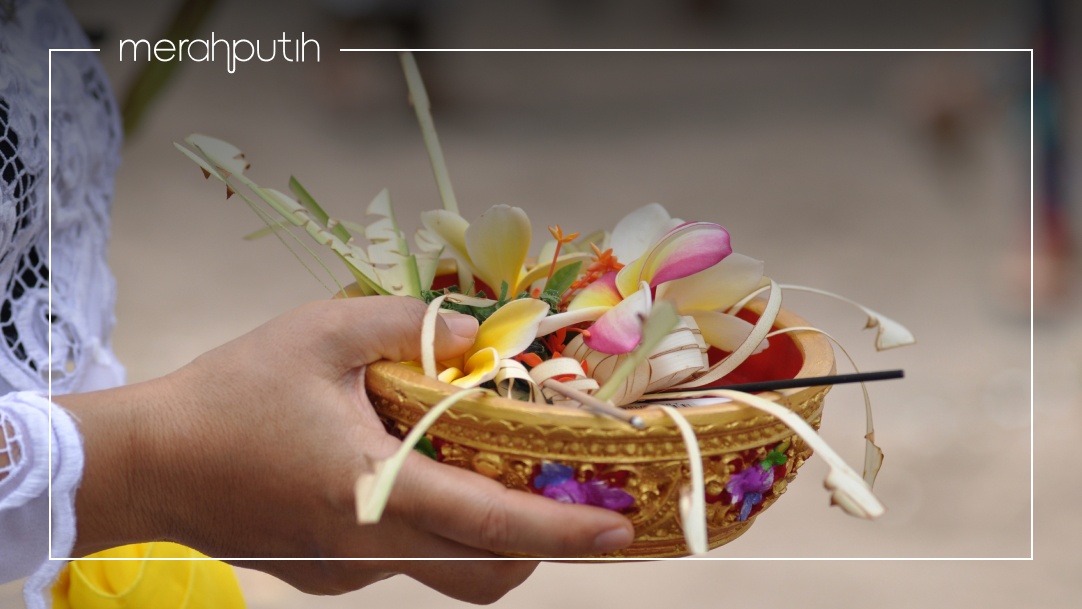As an island deeply rooted in its religion, Bali’s observation of Balinese Hindu rituals and ceremonies have been passed down from generation to generation. It not only influences the way individuals behave daily, but also how the entire society functions.
In their worship of the gods, the Balinese carry out countless religious rituals for various purposes. However, the sole reason is always to please and appease the gods. In almost every ceremony, you will find banten, an umbrella term referring to the physical offerings that are put together and prayed over, also known as sesajen.
The religious relevance of banten
For the Balinese, one of the goals of life on earth is to delight the gods and draw closer to Heaven. Banten becomes one of the religious objects that bring them closer to this purpose.
The various kinds of offerings are symbolic of man himself, with some representing the feet, belly button, stomach, breasts, arms, and head. With this symbolism, the banten is offered to the gods the same way man offers their lives up to the gods.
These sesajen functions as a sign of gratitude to the deities, a hope for restoration of the balance of nature, an offering, an accompaniment to pleas and requests, and a means of sanctification.
Banten in Balinese society and culture
In Balinese culture, women are in charge of putting together all the offerings for religious events. For this reason, mothers will pass down the skill of fashioning various banten, known as mejejaitan, to their daughters.
Preparing for a ceremony becomes a household and familial affair. With the frequency of these rituals, mejejaitan brings Balinese women together often, reinforcing the island’s values of gotong royong or mutual contribution.
Elements found in traditional Balinese offerings
Balinese Hinduism emphasises harmony with nature. This is manifested in the elements present in every single banten:
- Mataya: an element derived from plants such as flowers, leaves, and fruits
- Maharya: an element derived from anything that is birthed, often the meat of animals like pigs or goats
- Mantiga: an element derived from anything that hatches, such as poultry meat like chicken and duck
- Api: represents fire through incense that is then burned
- Angin: smoke from the above incense
- Logam: any kind of metal such as copper or nickel
- Panca Amerta: five kinds of liquids derived from
- Fruits
- Flowers (normally honey)
- Milk
- The earth
- Vapor
Various levels of banten
Religious offerings in Balinese Hinduism are classified based on complexity according to the kind of rituals they are used in.
- Nista: the simplest kind of offering used in smaller ceremonies or in personal prayers for safety, harmony, or thanksgiving
- Madya: an offering for the most high deity Sang Hyang Widhi particularly used in prayers to restore the balance of nature
- Utama: a sign of gratitude that brings one closer to the gods and helps maintain balance in every aspect of life
Common types of offerings
Below are just some of the many variations of banten.
Canang Sari
This is the type of offering you will often see lining the streets, in front of doorways, and in small shrines around the island. It’s a tray made of pandan leaves and filled with sweets, flowers, and incense. Visitors are advised not to step on or over the canang sari as it is considered a sign of disrespect.
The colours flowers themselves symbolise different gods. White petals point east as a symbol of Shiva. Red flowers point south to represent Brahma. Yellow flowers point west towards Mahadeva, and blue or green flowers point north to symbolise Vishnu, who is often depicted as a blue-coloured deity.
Banten Gebongan
Found in more prominent religious ceremonies, banten gebongan is a tall and intricate offering made by stacking larger amounts of the aforementioned banten elements to form a mound that tapers towards the top like a mountain. The word gebongan itself means “pile” or “mound.”
This offering symbolises the hope that blessings from the gods will reach man on earth below.
Banten Daksina
This type of sesajen is offered up in ceremonies where people gather to give thanks. It represents love and reverence for the most high God, Sang Hyang Widhi.
Banten daksina differs from other offerings. It consists of the following:
Rice grains
This serves as a symbol of fertility and prosperity
Coconuts
The coconut’s many layers represent the multiple layers or facets of life.
Eggs
The egg yolk stands for the deepest layer of the soul that connects the human to the divine. Egg whites symbolise the subtle body — thoughts, emotions, and any human aspect that is not physical. Finally, the egg shell represents the physical body.
Fruits
These represent life and honour.
Other forms of Balinese culture
Understanding the diverse array of offerings involved in Balinese Hindu ceremonies enriches your experience on the island as you come across locals carrying out their daily rituals. As is very clear, food is an integral aspect of religion on the island and a defining part of the tradition as well.
The care and attention the Balinese pour into their banten are the same that they put into their traditional dishes. Diverse ingredients, each contributing their own unique flavours, work together to form Bali’s iconic cuisine.
For a luxury Balinese food experience, visit Merah Putih restaurant in Petitenget. This is where your tastebuds will be spoiled with classic Indonesian recipes with a creative, modern flare. Book a table and claim these gift vouchers today.
FAQ
In their worship of the gods, the Balinese carry out countless religious rituals for various purposes. However, the sole reason is always to please and appease the gods. In almost every ceremony, you will find banten, an umbrella term referring to the physical offerings that are put together and prayed over, also known as sesajen.
Canang sari is the type of offering you will often see lining the streets, in front of doorways, and in small shrines around the island. It’s a tray made of pandan leaves and filled with sweets, flowers, and incense. Visitors are advised not to step on or over the canang sari as it is considered a sign of disrespect.
These elements are almost always present in every offering
– Mataya: an element derived from plants such as flowers, leaves, and fruits
– Maharya: an element derived from anything that is birthed, often the meat of animals like pigs or goats
– Mantiga: an element derived from anything that hatches, such as poultry meat like chicken and duck
– Api: represents fire through incense that is then burned
– Angin: smoke from the above incense
– Logam: any kind of metal such as copper or nickel
– Panca Amerta: five kinds of liquids derived from nature

